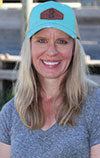When I was growing up, my family moved several times. I loved going with my parents to look at houses with the real estate agent. While we were out driving around, my dad would point out a ramble shamble home – a place that was literally falling apart – and proclaim, “It has potential!” My mom would roll her eyes, and I would watch my dad’s body language to see how serious he might be.
We never bought a house that was falling down but that phrase, “It has potential,” stuck with me.
As I mentioned last month, we are in the process of looking for a new place. The real estate market is fierce. The place we recently sold was definitely a fixer-upper when we got it years ago. We gutted the house, fenced the land, rebuilt water pathways, reseeded fields … We poured love into the place because we saw what it was underneath the rough exterior.
Looking at places to buy, we first look at the land. Yes, we need a home, but a home can be renovated, cleaned up, added onto – whatever the case may be. Does the land have potential? How can we add to the productivity of the land?
We’d love to have roots that we plant deep. Our path to a ranch may look different than others because we haven’t inherited land or millions of dollars, so we have found that we are reaching our goal with stepping stones.
Stepping stones. I’m sure you can relate – working toward something big but understanding it may take several smaller steps to get there.
It may look odd, like we are discontent. We aren’t per se. We are moving toward something bigger, and we can’t do that without change.
When I read stories of settlers from the 1800s, some were lucky enough to find one place and make a go of it. However, a fair number bought and sold and traded until they came to the place their families still live. Many of the ranchers also owned a general store or a mining claim or another business. They diversified to bring about success. I suppose in modern times, we are doing the same thing.
During the stepping stones processes, we have created business models that work for any climate and conditions. We’ve learned how to make money in the cattle industry (sometimes via the school of hard knocks). We know how to implement regenerative practices and utilize a feedlot. Perhaps most of all, we realize we aren’t in it just for us. We want to be part of a larger community.
Quite the eclectic community there is in agriculture. There are family ranches that have been around for generations and new people who’ve made a lot of money elsewhere now buying ranches. There are different opinions on everything from conservation easements to when to calve. Of course, it would be boring if we all thought and acted the same. Yet it is also important to recognize we are all in it together. During a time in history where much division is taking place, I continue to look for bonds that build bridges.
When we first moved to the place we sold, we were adamant we’d never move again. We loved (and still love) the land. This was going to be our place to settle down, grow old and eventually where our grandkids would visit. I remember we said we’d never leave unless it was boots up.
What changed?
Many things. When we moved here, it was for us. We loved the land and saw potential. Honestly, the place was hard work. Nothing came together easily. The day we moved in, the septic backed up and literally died. As we installed irrigation systems, we fought until we thought we’d lose the field to drought. Everything we did felt like climbing uphill backward, barefoot, in a snowstorm.
We spent years doing this kind of cleanup. It wore us out. We didn’t take time to rest or have fun.
The restoration of the land and the house was rewarding, despite the difficulty. Nothing beats watching something come alive again. Our kids grew in so many ways. Our son started the process loving to demolish the old (at 8, no old wall stood between him and his crowbar*) and then he learned to love carpentry and building.
While all of this was wonderful, it was limited. We are forever grateful for building our skill sets and restorative practices. Yet, couldn’t we partner with others and help the industry as a whole?
That is our goal now. It may mean a place of our own and partnering with other ranchers. It may mean working for someone else. It will mean sharing the abundance of resources we’ve created and used.
Today, the search continues. We look at another possibility this weekend. There is potential! Next month, I should have news.
*No one was injured during the remodeling phase.







